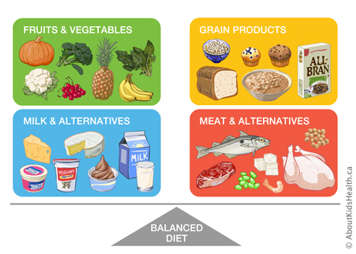
You are now probably familiar with the diet changes you need to make for your particular transplant, but there are lots of other things you can do to keep yourself as well as possible. Eating well helps to keep you healthy and looking good!
Healthy snacks
Snacks are an important part of your diet, but they can be a problem when they are unplanned or too frequent. Take time to read food labels and look for snacks that contain less than 100 calories per serving size.
Here are some ideas for healthy, low-calorie snacks.
- Raw vegetables with low-fat dip – make your usual dip using low-fat yogurt, light mayonnaise or non-fat sour cream
- Tossed salad with low-fat dressing
- Fresh, frozen or canned fruit served on its own or with low-fat or fat-free cheese or yogurt
- Fruit canned in its own juice
- Unsweetened cereals served plain or with skim or 1% milk
- Bread or unsalted crackers made with whole grains, plain or served with fruit spread or low-fat (7% milk fat) cheese
- Low-fat muffins
- Unsalted popcorn with just a bit of margarine
- Unsalted pretzels
- Bread sticks
- Plain cookies, arrowroots, social teas, animal crackers, gingersnaps
- Bagel (1/2 only)
- Rice cakes
- Low-fat yogurt (maximum 1% fat)
- Low-fat or fat-free pudding made with 1% or skim milk
- Sugar-free jello
- Sugar-free freezies or popsicles (homemade)
- Low fat or fat-free frozen yogurt
- Low-fat cottage cheese with fruit or unsalted crackers
- Water
- Skim or 1% milk.
Getting the right amount of fluids
Water is life! Drink mostly water instead of fruit drinks or soda, unless your transplant team tells you otherwise. Limit fruit juice to one cup a day and drink plenty of low-fat milk. See the fluids section for
kidney and
liver transplants to find out how much fluid you should drink each day.
Adding some colour to your plate
Keep your food intake colourful and balanced! Choose foods with different colours, as these will give you different vitamins and minerals.
Canada’s Food Guide lists four main food groups: vegetables and fruit; grain products; milk and alternatives and meat and alternatives. Each meal should contain at least three of these four food groups.
Eating out the healthy way
You might be used to eating “fast food” because it is more convenient or because eating out is a good way to spend time with your friends. But to really enjoy food without any after-effects, aim to go with healthier options, including:
- smaller portion sizes (or sharing with a friend)
- limited amounts of salty and fried foods
- more vegetables and whole grains.
Be careful with all-you-can-eat buffets! It is very easy to overeat to get your money's worth. Choose more fresh fruits, eat salads with olive oil and vinegar or low-fat dressing, and choose broiled main courses and steamed vegetables. Wait at least 20 minutes after eating to make sure you're really still hungry before going back for more.
| Instead of | Choose |
|---|---|
| Double-patty hamburger with cheese, mayo, sauce and bacon | Regular, single-patty hamburger without mayo or cheese |
| Fried chicken sandwich | Grilled chicken sandwich |
| Fried fish sandwich | Veggie burger |
| Salad with toppings such as bacon, cheese and ranch dressing | Garden salad with grilled chicken and low-fat dressing |
| Breakfast burrito with steak | Egg on a muffin |
| French fries | Baked potato or a side salad |
| Milkshake | Yogurt parfait |
| Chicken "nuggets" or tenders | Grilled chicken strips |
| Extra cheese or mayo and sauces | Limited or no cheese, mayo, or sauces |






